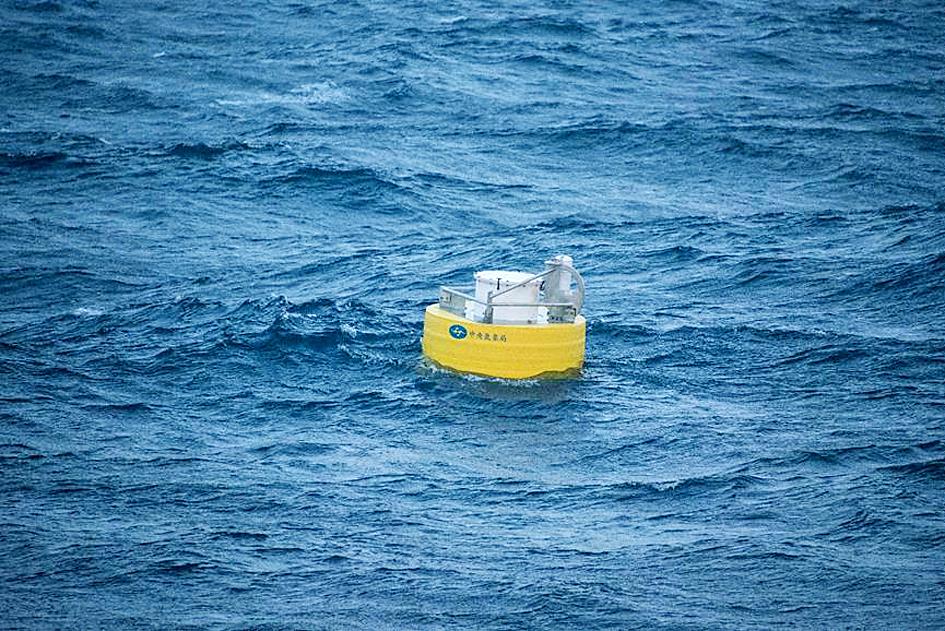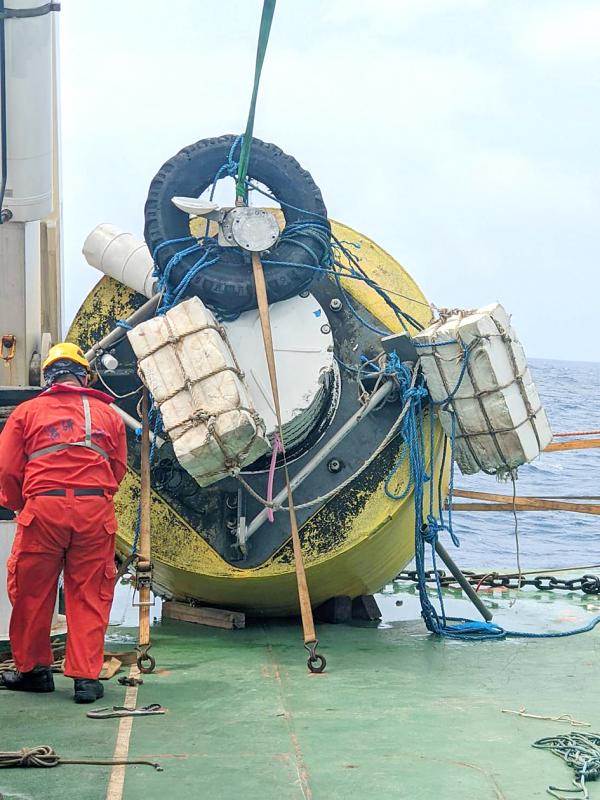The nation does not have an adequate number of buoys along the southwest coast for a tsunami warning system after two buoys were destroyed at sea, the Central Weather Bureau (CWB) said yesterday.
The US National Oceanic and Atmospheric Administration developed a monitoring system using mid-frequency buoys manufactured by Science Applications International Corp (SAIC), the bureau said, adding that Taiwan joined the US Pacific Tsunami Warning Centers’ (PTWC) observation network after it purchased a monitoring system in 2018.
If large earthquakes occur in Indonesia or the South-Pacific region, the buoy system transmits data to the PTWC and the weather bureau, CWB Seismological Center Director Chen Kuo-chang (陳國昌) said, adding that the information helps the two agencies more accurately estimate a tsunami’s impact and issue warnings accordingly.

Photo courtesy of the Central Weather Bureau
Taiwan installed a monitoring buoy off its southeast coast and another buoy off its southwest coast, Tung Chun-ci (滕春慈) of the CWB Marine Meteorology Center said.
The first buoy has functioned reliably since its installation, but the installation of the second buoy was not as successful, Tung said.
The New Ocean Researcher ship installed the second buoy in October 2018, but it stopped sending signals in January 2019, she said.

Photo courtesy of the Central Weather Bureau
The buoy was thought to have sunk or drifted from its original location after being hit by seagoing vessels, she added.
Another buoy was installed at the site in August last year, but it began making abnormal reports on March 4, Tung said, adding that the buoy still sent signals, although tracking showed that it had drifted away from the installation site.
When the buoy was located on March 13, researchers found that its steel cables had been cut and its equipment removed, rendering it ineffective.
“The buoys installed by the CWB and the National Taiwan University [NTU] Ocean Center had anti-collision lights, radar reflectors and the CWB’s name on them to alert vessels,” Teng said.
“We think it was unlikely that the buoys were destroyed by Taiwanese fishers. They might have been damaged by fishing vessels from other countries or military ships,” she said.
“As the buoys did not have a surveillance device, it would be difficult for us to determine what happened,” she added.
Yang Yiing-jang (楊穎堅), a professor at NTU’s Institute of Oceanography and team leader at the Ocean Center, said that researchers around the world have encountered similar problems.
“The problem is that tsunami buoys are very expensive, with each set costing NT$30 million [US$1 million], which is three to four times more than a meteorology buoy. We can only purchase tsunami buoys from SAIC,” he said. “If a buoy is broken, it has to be sent back to SAIC for repairs, because Taiwan does not have the technology to fix it. Reinstalling it also requires SAIC’s assistance.”
The CWB is also in a bind when it comes to choosing the proper site to install a tsunami buoy, Teng said.
“Installing a buoy farther from the coast would alert people longer before a tsunami strikes, but it would be more difficult to ensure that the buoy is intact,” Teng said. “It is easier for us to monitor the buoy if it is installed closer to the coast, but then the tsunami alert time is shorter.”
Tsunami alerts could be issued without the benefit of tsunami buoys or submarine cables, CWB Director-General Cheng Ming-dean (鄭明典) said.
“We have our own earthquake detection system that gathers information and also monitors tsunami alerts from the PTWC,” Cheng said. “Tsunami buoys or submarine cables help give people a longer alert time and enable us to gauge a tsunami’s impact more accurately before issuing warnings. We hope to open another public tender for a submarine cable project after raising the funds for it.”
The CWB has planned to install an 800km-long submarine cable from off the southern coast of Pingtung County to Luzon, Philippines, to detect tsunamis, but it has yet to secure a contractor for the project after five public tenders.

Taipei and New Taipei City government officials are aiming to have the first phase of the Wanhua-Jungho-Shulin Mass Rapid Transit (MRT) line completed and opened by 2027, following the arrival of the first train set yesterday. The 22km-long Light Green Line would connect four densely populated districts in Taipei and New Taipei City: Wanhua (萬華), Jhonghe (中和), Tucheng (土城) and Shulin (樹林). The first phase of the project would connect Wanhua and Jhonghe districts, with Chiang Kai-shek Memorial Hall and Chukuang (莒光) being the terminal stations. The two municipalities jointly hosted a ceremony for the first train to be used

The Mainland Affairs Council (MAC) yesterday said it is fully aware of the situation following reports that the son of ousted Chinese politician Bo Xilai (薄熙來) has arrived in Taiwan and is to marry a Taiwanese. Local media reported that Bo Guagua (薄瓜瓜), son of the former member of the Political Bureau of the Central Committee of the Communist Party of China, is to marry the granddaughter of Luodong Poh-Ai Hospital founder Hsu Wen-cheng (許文政). The pair met when studying abroad and arranged to get married this year, with the wedding breakfast to be held at The One holiday resort in Hsinchu

Tropical Storm Usagi strengthened to a typhoon this morning and remains on track to brush past southeastern Taiwan between Friday and Sunday, the Central Weather Administration (CWA) said. The storm, which as of 8am was still 1,100km southeast of southern Taiwan, is currently expected to enter the Bashi Channel and then turn north, moving into waters southeast of Taiwan, the CWA said. Because of its rapid speed — 28kph as of 8am — a sea warning for the storm could be issued tonight, rather than tomorrow, as previously forecast, the CWA said. In terms of its impact, Usagi is to bring scattered or

An orange gas cloud that leaked from a waste management plant yesterday morning in Taoyuan’s Guanyin District (觀音) was likely caused by acidic waste, authorities said, adding that it posed no immediate harm. The leak occurred at a plant in the district’s Environmental Science and Technology Park at about 7am, the Taoyuan Fire Department said. Firefighters discovered a cloud of unidentified orange gas leaking from a waste tank when they arrived on the site, it said, adding that they put on Level A chemical protection before entering the building. After finding there was no continuous leak, the department worked with the city’s Department